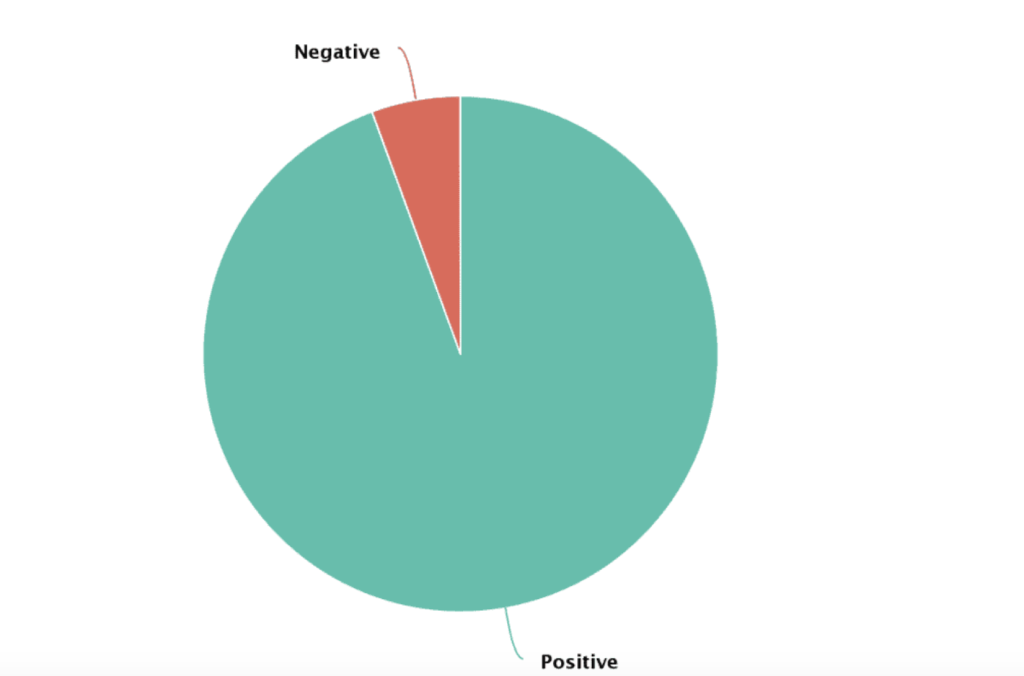Have you been looking for ways to measure customer sentiments, experience, and satisfaction? Then you are not alone! Technological advancements make measuring and gauging customer sentiments easier than ever using sentiment analysis.
Now, more than ever, businesses are taking an interest in getting insights into how customers feel about their brands. According to a study, 54% of companies now analyze customer sentiment, with this percentage expected to reach 80% in 2023!
? Read Media Monitoring: The Ultimate Guide
The most successful businesses understand the importance of what their customers say and how it impacts their marketing efforts.
This article explains sentiment analysis – what it is, how it works, and the top 5 examples of sentiment analysis.
What Is Sentiment Analysis?
Sentiment analysis uses text analysis and natural language processing to understand customers’ positive, negative, or neutral sentiments. In short, sentiment analysis helps to understand the author’s underlying emotion and tone in the piece of writing.
Sentiment analysis has become crucial for businesses to gain more profound insights into what customers want in their products. Companies can use these insights to optimize their marketing strategies, attract and retain customers, and increase revenue.
These days, there are numerous places to find customer sentiment – comments, product reviews, direct feedback, shares, and mentions. Now, customers openly express their opinions and thoughts on brands. You must leverage sentiment analysis to understand further and learn what makes your customer happy or disappointed.
According to Nate Tsang, Founder and CEO of WallStreetZen, “Sentiment analysis is a handy tool in helping businesses learn more about their customers’ pain points. This information allows businesses to tailor their products and services to meet customer needs.”
You must go the extra mile to find out what your customers say. It will give you the edge you need to improve your products and services and stay ahead of your competitors. If you need a strategy to boost sales while enhancing users’ experience, then sentiment analysis is the way.
Read All You Need to Know About Brand Sentiment Analysis

How Does Sentiment Analysis Work
Sentiment analysis relies on artificial intelligence to determine textual data’s underlying tone and emotion.
The software on which sentimental analysis is based is trained on millions of texts to detect sentiment. Machine learning allows the software to learn more independently to become more accurate at predicting the outcome of an analysis.
Sentiment analysis AI breaks a message into text blocks and assigns a sentiment score to each block.

As an example of sentiment analysis, take the following customer review:
“I recently bought the new HP EliteBook 840 and was impressed. It is ultra-slim and lightweight with great functionality. The battery life was a bit disappointing, but I am happy with the purchase.”
So how exactly does the sentiment analysis AI interpret the message? It breaks it down into separate pieces of text, such as:
1. “was impressed.”
2. “It is ultra-slim and lightweight with great functionality.”
3. “The battery life was a bit disappointing.”
4. “I am happy with the purchase.”
The sentiment analysis tool then assigns a sentiment for each block of text. The first, second, and fourth statements are very positive, while the third statement is negative. This way, the decision maker can understand what the customer thinks about individual parts or look at the overall picture.
When appropriately used, sentiment analysis helps brands understand where to improve. In the example above, the company will know that work is required on the computer’s battery life.
Top 5 Examples of Sentiment Analysis
Sentiment analysis is a very effective tool that is used across various industries. Here are the top 5 most popular examples of sentiment analysis:
Social media tracking
In recent times, social media has evolved beyond being a place for just entertainment. Many people now go on social media to voice their opinions and reviews about businesses. There are about 4.7 billion social media users, about 59.3% of the world population. Every minute, these users send thousands of messages that contain valuable insights into their views about businesses.
Social media is quickly becoming the preferred complaint platform for many customers. They believe it gets them better and faster responses than the official complaint channel. For this reason, brands have changed how they interact with their audience. And this is why one of the first examples of sentiment analysis we’re mentioning refers primarily to social media. Let us clarify.
Read How to Do Social Media Sentiment Analysis in Politics

Brands must quickly identify customers’ bad experiences and respond to them personally and effectively. That can help to turn the situation around and leave the customer feeling good. Using sentiment analysis AI helps brands quickly detect unhappy customers, sort issues by urgency, and prioritize responses.
Do you always want to be a step ahead of a potential PR crisis? Use real-time sentiment analysis. Real-time sentiment analysis allows you to identify a customer’s bad experience posted on social media before it goes viral. It can go a long way in helping you protect your brand reputation.
Brand monitoring
Other examples of sentiment analysis go a bit further than social media. To brand reputation, to be more precise.
Sentiment analysis is an excellent tool for keeping an eye on your brand reputation. Besides social media, customers have conversations and voice their opinions on blogs, forums, and review sites. So you must keep an eye on the different platforms, especially review sites.
According to Michael Nemeroff, CEO and Co-Founder of Rush Order Tees, “Product reviews play a crucial role in the customer’s buyer’s journey. It is important to ensure that your brand has positive reviews, which gives it credibility and attracts more customers.”
With sentiment analysis, you can get detailed insights into how customers feel about your brand. It lets you know the specific aspects of your products or services that are being praised or criticized. And helps you figure out ways to improve on what’s not working to help elevate the customer experience.

Customer support analysis
Customer service, when done well, can have a significant impact on a business’s marketing efforts. Providing excellent customer service should be a priority for every business looking to retain customers and increase revenue.
A survey showed that 80% of customers stopped doing business with a company after experiencing poor customer service. To avoid your customers looking for another service provider, you must ensure that your customer service experience is top-notch.
According to George Tsagas, Owner and Founder of eMathZone, “There’s no doubt that companies who provide excellent customer service generate more revenue than those whose customer service is below par. Give your customers a great experience, and they will be happy to come back to you and refer you to others.”
Integrating sentiment analysis into your customer service strategy will make your interactions faster, more personalized, and more effective. By analyzing sentiment on feedback about your customer support, you can get detailed insights into aspects that require improvement.
Read How to Conduct Sentiment Analysis to Improve Customer Experience?

Customer feedback analysis
Collecting customer feedback is key to making informed decisions and innovations that guarantee greater customer satisfaction.
According to Daniel Apke, CEO of Land Investing, “Customer feedback is a measurable parameter that businesses can employ to determine the level of customer satisfaction. Listen to your customers, and improve your product until it meets their needs. Your business will flourish.”
Sentiment Analysis lets you determine what customers like and dislike about your products and services. If you don’t consider customer feedback, you’re likely to miss out on a lot of potential revenue.
Market research
The use of sentiment analysis goes beyond customer reviews. You can use them to gain insights into new market trends and research what your competitors are doing. By looking at your competitor’s reviews, you can find out in which areas they are struggling. You can use the opportunity to highlight your strength in these areas, thereby attracting disappointed customers from your competitors.
If you’re about to release a new product, sentiment analysis can tell you how customers feel about it. What kind of feedback is it getting ahead of its release? Are they positive or negative? Do customers find it exciting? Do they think the product will be helpful to them?
Read Sentiment Tracking: How to Get Inside Your Customers’ Minds?
Conclusion
Your customers are the soul of your business and the solution to almost any problem you face. Thanks to platforms like Determ, you can get unique insights into your customer’s views and opinions.
What do people like or dislike about your brand? What features of your products are great? Which aspects still need more improvement? What do they think about your company’s customer service? Sentiment analysis provides answers to these and many more questions.
Book a demo, find out the benefits of sentiment analysis through Determ, and watch your business take off to the next level!



